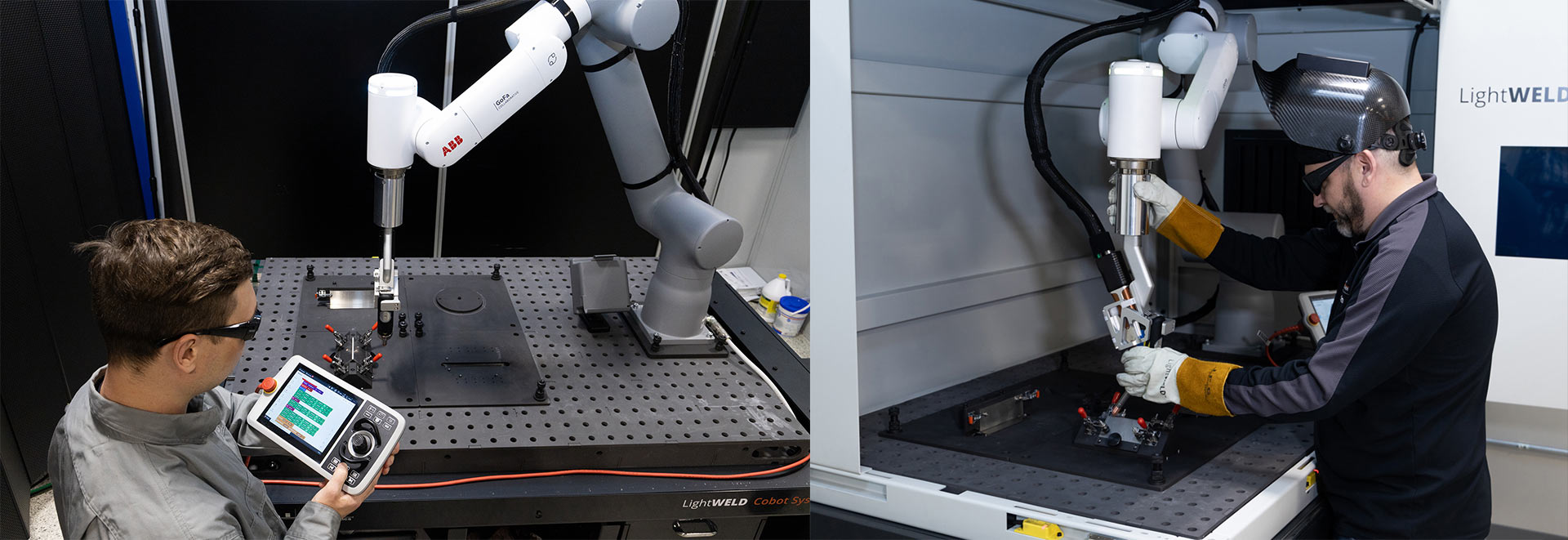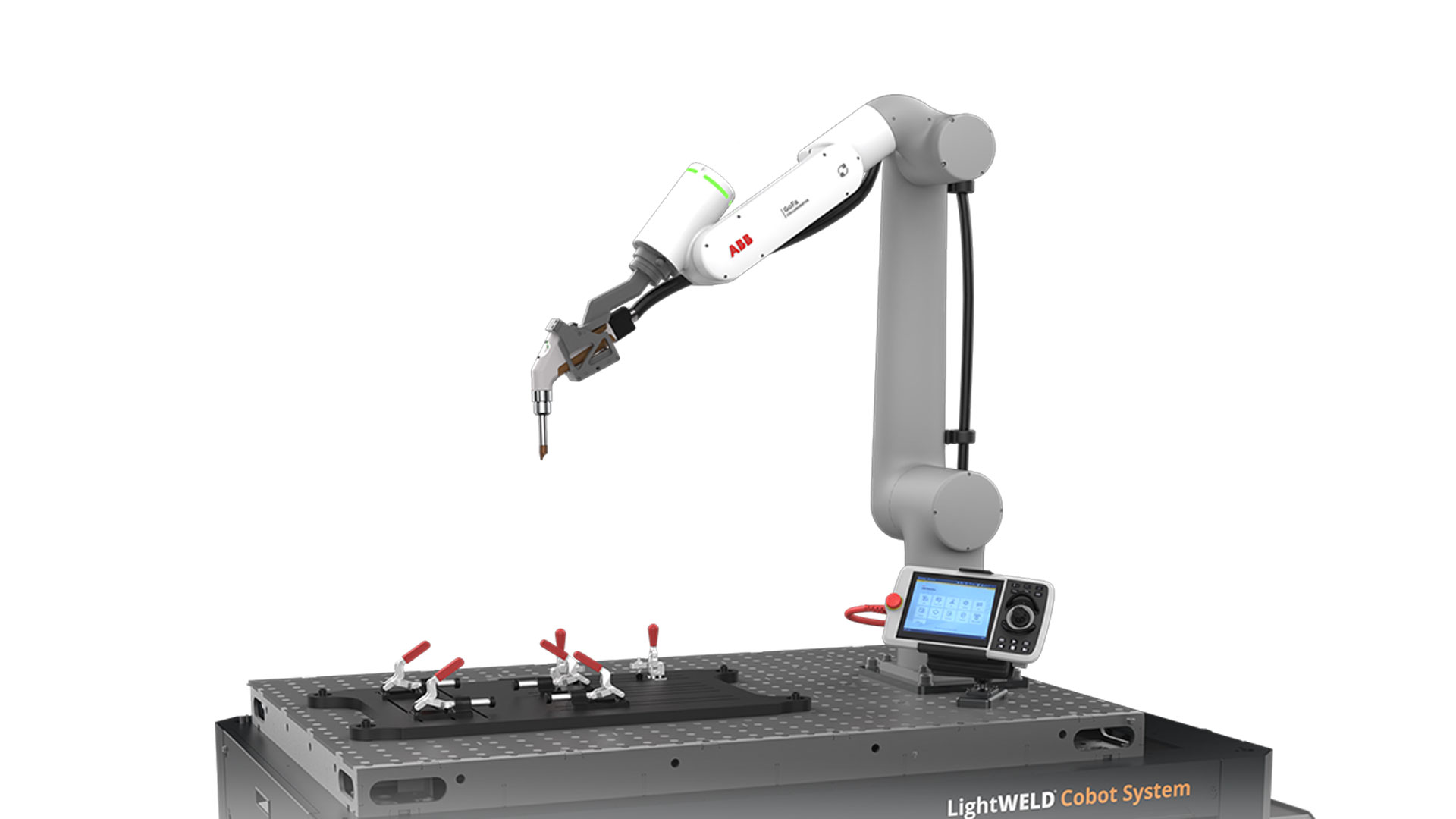Ongoing advances in automation continue to transform manufacturing by improving quality, increasing productivity, and reducing costs. But the cost, complexity, and large footprint of traditional automation systems often make them unfeasible for smaller operations.
Now collaborative robots, or cobots for short, have stepped in to make automation more accessible to smaller-volume manufacturers. These systems share many key benefits with traditional automation but at a lower price and in a smaller package while being simpler to program and operate than more sophisticated solutions.
Laser welding cobots offer a particularly compelling value proposition. By combining the inherent precision and speed of laser welding with automated motion, they can significantly enhance welding productivity.
But how do you identify the right task for a laser welding cobot and integrate one successfully? Here we’ll walk through the key considerations for identifying, specifying, and successfully deploying one in your operation.
Finding the Right Application
What applications can benefit from a cobot?
Cobots are best suited to applications with moderate production volumes, both for larger assemblies that require several welds or arrays of smaller parts. Good welding cobot applications often include jobs where manual welding is inconsistent or time-consuming, but a full industrial automation setup is not justifiable.
Like any form of automation, cobots perform best when the process doesn’t vary significantly from part-to-part. This means consistent part dimensions, repeatable fixturing, and predictable weld paths. If you’re welding the same assemblies regularly and want to improve consistency and productivity, a cobot could be the right tool.
But that doesn’t mean that laser welding cobots are not useful for smaller batches and one-off jobs. The relative ease of programming means that a laser welding cobot can deliver the desired results on low volume runs in a way that’s effectively impossible for a traditional welding robot.
Straight-line welds, circular seams, and small radii are all well within cobot capabilities. In fact, any kind of complex or intricate weld path that is difficult to execute by hand may be done better by a cobot.
However, jobs involving irregular or warped parts with poor fit-up can create problems. This is because laser welding is generally more demanding than arc welding in terms of fit-up. Wire-fed applications are somewhat more forgiving, but autogenous laser welding typically requires gap sizes of less than a millimeter.
The first step in evaluating a cobot is to assess both technical fit and operational ROI. Does the process repeat often enough to justify automation? Are weld quality and consistency an issue, or is labor availability a pain point? Can fixturing be standardized? If the answers are yes, a laser welding cobot could streamline your workflow and improve your output without the overhead of traditional automation.
Safety Considerations
Since cobots are specifically intended for frequent human interaction, their safety requirements differ significantly from those of traditional robotic systems. This is especially true in laser welding applications.
Laser welding cobots come in two basic configurations – open and closed. The type chosen directly influences the necessary safety measures and protective equipment.

In a closed setup with an integrated enclosure, the cobot and welding process are fully contained within a cabinet or cell. These enclosures are typically interlocked, so the laser automatically shuts off if a door is opened.
This is generally classified as a Class I laser system, meaning the laser is considered safe under normal operating conditions and no special PPE is required. Integrated fume extraction is also included, helping to manage any smoke or particulates generated during welding.
An open cobot system lacks built-in containment, so it must be positioned behind laser-rated barriers or curtains to shield nearby workers from direct or reflected beams. These setups are classified as Class IV laser systems.
With open laser welding cobot setups, operators typically load and position the part then initiate the weld cycle before stepping back or moving behind a barrier while the laser is active. Remaining near the cobot during welding is safe provided the correct PPE is worn – laser welding glasses at a minimum and potentially a laser welding helmet and flame-resistant clothing – but typically operators take the opportunity to focus on other work while the cobot runs a cycle.
Several factors, including cost, production volume, and especially workflow efficiency, influence the choice between a closed and open cobot.
If space is limited or you are unsure how to implement proper safety protocols, a closed cobot can greatly simplify and expedite installation.
If your operation values quick part changeover and uninterrupted access, an open system may be preferred over an enclosed system that requires opening a door to access parts. Open systems also offer maximum range of motion to the cobot arm which is an important consideration when welding larger, more complex parts.
Planning Cobot Installation
Choosing the right location for your laser welding cobot is about more than just finding open floor space. Success requires integrating the system seamlessly into your production.
Ideally, the cobot should be placed where it supports efficient part movement within the process flow, minimizes travel time, and doesn’t disrupt existing operations.
Laser welding cobots are relatively compact, and many come on rollers that allow for flexible deployment. However, they’re not typically moved frequently in daily use, especially when tied into a fixed fume extraction system. It's best to place the unit where it can stay put and operate efficiently.
Power requirements are straightforward: most cobot systems run on standard 120V, while the laser welding unit itself may require 208V single-phase power. Again, fume extraction is usually necessary, which may mean a dedicated exhaust system to ensure a safe and compliant working environment.
Choosing the Right Size Cobot
Part of choosing the right cobot system is choosing the right size arm. A cobot that’s too small can limit your weld coverage because it simply can’t reach the parts, or it might require awkward part positioning. An arm that’s too large can take up unnecessary space and add cost.

The IPG LightWELD Cobot System can be fitted with two cobot arm sizes with reaches of either 1370 mm or 1620 mm.
Start by conducting a simple “reach study.” This involves mapping out your part geometries and weld locations to ensure the cobot can comfortably access each joint within its range of motion – both linear and angular. Some vendors offer virtual simulation tools to help visualize and validate reach in a digital environment before the system is purchased or installed.
It’s also wise to consider future-proofing in the event your parts and assemblies change in size or configuration in the future.
Setting Up for Cobot Success
One of the key advantages of laser welding cobots is their approachable user interface. However, despite their relative ease of use, cobot integration is not completely foolproof.
Often, the most effective new laser welding cobot deployments start by identifying an internal “owner” for the system. This is someone in your operation who goes beyond just knowing how to use the system – they are also motivated to champion the technology.
This technology owner doesn’t need to be a robotics expert. But they should be technically inclined and willing to take responsibility for programming and oversight.
Basic operation, like loading and unloading parts, can typically be handled by regular production staff. But programming the cobot, adjusting parameters, and managing system performance requires someone who understands both the welding process and the production context. That’s where vendor-led training is often invaluable.
Manufacturers like IPG provide training for both the cobot system and the laser welding unit (such as LightWELD). This training includes the basics of operating the system, plus how to recalibrate tools like the “bullseye” fixture used when swapping components or shifting between manual and automatic modes. With proper training, operators can confidently teach new weld paths, optimize cycle times, and maintain consistent quality.
Investing time in training ensures you do more than just automate a task. Rather, you build internal expertise that supports scalability and long-term success.
Vendor Support
Choosing a cobot also means choosing a cobot vendor. The level and quality of support offered by your cobot supplier makes a significant difference in how quickly you get up and running, and how well the system performs over time.
Look for a vendor that offers responsive, expert support both during and after installation. Attentive service and support is especially valuable for shops with limited in-house automation expertise or those operating on tight production schedules.
Beyond reactive support, consider the vendor’s ability to help you scale. Can you easily transfer programs between multiple cobots? Is training offered for both the system and the welding process? Are simulation tools available to test setups before they’re live? These capabilities help maximize your investment and reduce downtime.
A good vendor will also act as a strategic partner, offering guidance on fixturing, process optimization, and ongoing training. Especially for first-time automation users, having a knowledgeable and engaged vendor can turn a successful install into a scalable, repeatable automation strategy.
Getting Started with a Cobot Solution
Implementing a laser welding cobot solution can seem intimidating, particularly for those with no automation or laser welding experience. Fortunately, the laser welding experts at IPG are ready to help. Getting started is easy — send us a sample, visit one of our global application labs, or just tell us about your application.





